Managing Snow On Corrugated Metal Roofing: Report From The Alpine SnowGuards Research Facility
 |
Brian Stearns |
By Brian Stearns, President & Founder, Alpine SnowGuards
For those of you who have been following the continued research we’ve been conducting on the research facility we had constructed here at Alpine SnowGuards, you will recognize that we’ve observed some very interesting activity, and have some
valuable take-aways. Some we expected – and some we didn’t. You’ve been able to see what we’re observing right along with us!
If you haven’t been following, this is a great place to start! If you want to take a few minutes to catch up, take a look at the postings from our blog below before reading on:
• Alpine SnowGuards In 2020: A First-Of-Its-Kind Research Facility
•
Snow Guard Performance Testing
• Buckles & Cornices: Alpine’s Research Continues
• Alpine Research Facility Update: Managing Snow On Synthetic Slate Shingles
• Alpine Research Facility Update: Managing Snow On Composition Shingles
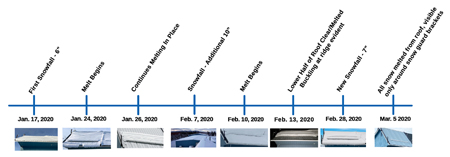 |
Click image above to enlarge timeline. |
Snow Management On Corrugated Metal Roofing
As our research continues on the roof mock-ups we’ve constructed at our Vermont facility in 2019, it’s worth noting that there were very few snowfall events, and so there were also very few opportunities to collect and analyze data.
The timeline (above left) shows the dates of each snowfall event, and the associated snow accumulation.
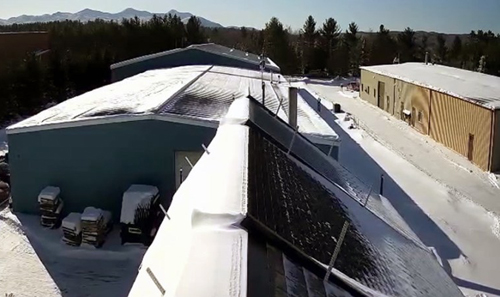 The most significant events associated with the snowfall relate to drifting of snow from the Northwest, 7/12 pitch roof, to the steeper, 12/12 pitch Southeast
side of the building. It’s important to point out that similar drifting situations occurred on our factory building, as well as neighboring factory buildings.
The most significant events associated with the snowfall relate to drifting of snow from the Northwest, 7/12 pitch roof, to the steeper, 12/12 pitch Southeast
side of the building. It’s important to point out that similar drifting situations occurred on our factory building, as well as neighboring factory buildings.
It wasn’t our intent to study these neighboring roofs – it turns out that a few of the 16 cameras we had mounted on the mock-up are positioned in a way that allows sweeping views, as well as the collection of this additional data. I point
this out to show that the drifting we observed wasn’t directly related to differing roof pitches on the mock-up. Instead, the drifting was related to building orientation, wind direction and lack of obstructions like trees and taller buildings.
All of the latter variables affect drifting and can be taken into consideration by a local engineer based on site specifics.
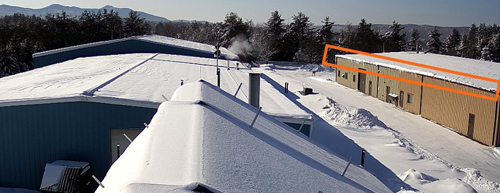 Notice (left photo) the cornices of snow and ice that gradually crept out and over the eaves of both our 12/12 pitch mock-up and the 3/12 pitch roofs
on the steel buildings in the area immediately around our facility.
Notice (left photo) the cornices of snow and ice that gradually crept out and over the eaves of both our 12/12 pitch mock-up and the 3/12 pitch roofs
on the steel buildings in the area immediately around our facility.
Our belief is that this creeping is the direct result of heavy snowfall with significant drifting, followed by cold temperatures, and finally, compounded by heat loss from within the building. A thin layer of ice developed close to the roof surface, facilitating
a slow, glacier-like creep of the snow and ice mass at the eaves.
 It’s important to note that this phenomenon occurred on buildings with and without snow guards installed. Take a look at one of our neighboring buildings
(right photo) and the damage their gutters sustained as a result of the above scenario. These gutters were installed more than 10 years ago, and this is the first year their gutters saw damage of any form.
It’s important to note that this phenomenon occurred on buildings with and without snow guards installed. Take a look at one of our neighboring buildings
(right photo) and the damage their gutters sustained as a result of the above scenario. These gutters were installed more than 10 years ago, and this is the first year their gutters saw damage of any form.
This Is An Important Lesson:
Above/upslope from where snow guards are installed, sliding snow and ice is managed as expected. On the other hand, they do nothing in the way of managing the mass below them. This may seem like an obvious statement, yet even buildings with snow guards
installed can experience this creep of snow mass that eventually hangs as a cornice below the snow guards, and in some cases, over the eaves of a building. If this is happening on your building, please take the time to remove the mass. It can be very
heavy, destructive and dangerous when it releases.
For those of you who read the other blog postings about our research (referenced near the start of this article), you’ll remember that there was very little buckling of snow above the snow guards on the synthetic slate roof, and little-to-none on
the composition shingle roof. On the composition shingle roof, this buckling phenomenon appears to be minimized by the surface friction that is inherent to composition shingles.
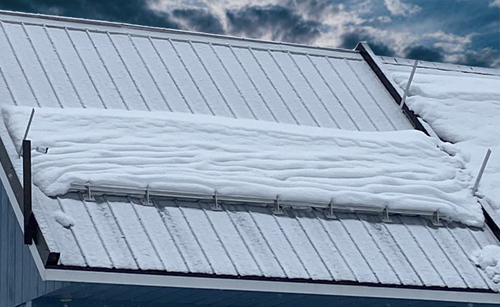 On the synthetic slate roof, the buckling phenomenon appears to have been reduced by the placement of multiple tiers of snow guards placed up the slope
of the roof. On this corrugated mock-up (left photo), there was one tier of guards placed 24” up from the eave. This left a distance of 12 feet from the snow guards to the peak of the roof. Buckling began to occur as the upslope mass slumped
against the one tier of snow guards. Based on winter conditions to date, the snow mass eventually melted and came off the roof as water. This is an ideal result.
On the synthetic slate roof, the buckling phenomenon appears to have been reduced by the placement of multiple tiers of snow guards placed up the slope
of the roof. On this corrugated mock-up (left photo), there was one tier of guards placed 24” up from the eave. This left a distance of 12 feet from the snow guards to the peak of the roof. Buckling began to occur as the upslope mass slumped
against the one tier of snow guards. Based on winter conditions to date, the snow mass eventually melted and came off the roof as water. This is an ideal result.
This bucking can sometimes cause less than desirable results. During wet, heavy, deep snowfall events it’s not uncommon for the snow mass to buckle, lift away from the roof, crest like a wave and come over the top of the snow guards.
Alpine believes that roof surfaces that are 8/12 pitch or greater, in areas with ground snow loads of 40 psf or greater, are more susceptible to buckling events that can crest and come over the snow guards. For this reason, we believe that steeper roof
pitches (8/12 and over) show better snow management results using taller snow guards, multiple tiers of snow guards or hybrid systems that utilize pipe-style snow guards at the eaves, combined with pad-style snow guards that distribute the mass more
evenly, similar to the granular surface of composition shingles, as mentioned above.
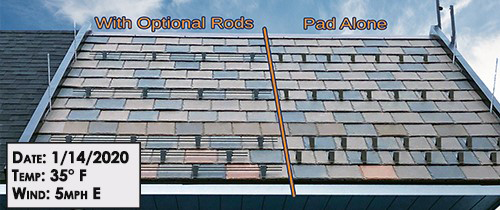 Using a barrier type of snow guard at the eaves, like a pipe-style system, makes sense as a way to increase safety as well as a way to add friction upslope.
This will reduce negative aesthetic impact while aiding in the distribution of friction points.
Using a barrier type of snow guard at the eaves, like a pipe-style system, makes sense as a way to increase safety as well as a way to add friction upslope.
This will reduce negative aesthetic impact while aiding in the distribution of friction points.
Conclusion To Date:
Overall strength of the snow guard brackets does not necessarily correlate to system performance.
Proper placement of snow guards in the appropriate quantities seems to relate more to system performance than individual component strength.
Two Questions Should Be Considered:
Are snow guard manufacturers who are using pull and shear testing actually performing the wrong tests?
Would performance testing be more relevant? After all, if something doesn’t perform to expectations, the product is really only as good as the testing behind it. Alpine’s research mock-up is a great example to follow in terms of analyzing
how snow guards perform in actual, real-life conditions. Or, testing performed by an accredited laboratory, utilizing manmade snow, wind, freeze, thaw, etc.
Your feedback and observations are always welcome and appreciated.
About Alpine SnowGuards®
 Established
in 1993 and employee owned, Alpine SnowGuards designs, engineers and manufactures 50+ snow and solar snow management systems for all roof types, new or retrofit, from its facilities in Morrisville, VT. Alpine’s 11 snow guard designs for “clamp-to-seam”
systems utilize round-point set screws to avoid damaging roof panels, allowing for a firm hold all winter long while keeping snow in its place. Alpine’s 8 products for corrugated metal utilize a compression fit seal to prevent water from leaking
into the roof decking and causing issues. All of Alpine’s snow guards are rigorously performance tested at its in-house testing facility, by 3rd party testing facilities, and in the field by roofing experts. When installed properly, they will
not void manufacturer warranties.
Established
in 1993 and employee owned, Alpine SnowGuards designs, engineers and manufactures 50+ snow and solar snow management systems for all roof types, new or retrofit, from its facilities in Morrisville, VT. Alpine’s 11 snow guard designs for “clamp-to-seam”
systems utilize round-point set screws to avoid damaging roof panels, allowing for a firm hold all winter long while keeping snow in its place. Alpine’s 8 products for corrugated metal utilize a compression fit seal to prevent water from leaking
into the roof decking and causing issues. All of Alpine’s snow guards are rigorously performance tested at its in-house testing facility, by 3rd party testing facilities, and in the field by roofing experts. When installed properly, they will
not void manufacturer warranties.
Sign up for a free snow guard calculator at AlpineSnowGuards.com for access to an all-products price list, free recommended layouts specific to your project, instant quotes, the ability to place orders online and more. Be sure to check out the “Products by Roof Manufacturer” page which helps installers
select the best and most appropriate device during the bidding phase of a project. To learn more about snowguards for standing seam metal roofs, visit https://alpinesnowguards.com/roof-type/standing-seam.
For more information on all of Alpine SnowGuards' products, visit www.alpinesnowguards.com.





